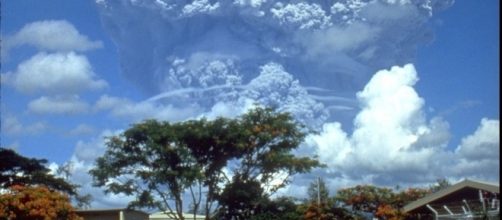Since 1993, satellites have been measuring the planet’s sea level rise and have come to a stunning conclusion: it’s not as bad as they thought. But now a new study published today in Scientific Reports hopes to answer the question of why sea level rise isn’t occurring faster in a global warming world. The latest excuse: The 1991 Mount Pinatubo volcanic eruption blocked out sunlight, which prevented increased warming of the planet and oceans.
Everything sounds reasonable given the Pinatubo eruption spewed out roughly 17 megatons of sulfur dioxide, which reacts with water vapor to create a tissue-thin haze in the stratosphere that blocks out some sunlight.
It takes about two years for this haze to dissipate.
Only in computer models
The study was led by the National Center for Atmospheric Research (NCAR) and its authors used computer models to subtract the effects of the cooling caused by the volcanic eruption. Once that was done, the computer models showed accelerated sea rise. Here’s the kicker: that would explain only two years of cooling. The sea level rise has been consistent at 2-3 mm per year since the satellite record started.
1991 Mount Pinatubo Eruption Has Kept Rising Oceans at Bay—But Not for Long - Motherboard https://t.co/evf7hXG8jL
— AshCloudNEWS (@Volcano_NEWS) August 10, 2016
It goes on to say that after the ocean cooling recovered, sea level rise “began at a rate up to 7 mm.” Note the “up to 7 mm.” That’s because not all sea level rise is created equal; it varies depending on your location and time of year.
The average of all the measurements taken still show a rate of only 2-3 mm per year.
Observable facts vs. simulations
The study notes that since no visible eruptions have occurred since Pinatubo blew its top, we may experience a faster rate of sea level rise in the near future. Which is a tortured way of telling readers that sea level rise isn’t quickening but may be just around the corner. In fact, none of the catastrophic predictions made by the Intergovernmental Panel on Climate Change (IPCC) and former VP-turned-activist Al Gore have come true. Geologist James Kamis said in an emailed statement that there are actual observable facts to bear in mind when interpreting this new study:
- New research proves that geological and ocean current forces are the reason Antarctica has gained ice for 35 years. This shows that natural forces override any effects of global warming. Keep in mind Antarctica is larger than the United States.
- The atmosphere above West Antarctica hasn’t warmed since 1998 as previously thought by climate alarmists. New research shows it’s cooling. A related study, also released, shows that bottom melting of glaciers in West Antarctica is from geological sources and NOT atmospheric global warming.
- Numerous studies show that El Niños are NOT from manmade global warming. The biggest mega-climate event of the decade is also behind many of the climate-related headlines: warmest year ever claims, ocean acidification, California drought, coral bleaching, altering of the Pacific Ocean animal migration patterns, etc…, have nothing to do with humans.
- The Arctic is not ice free and appears to be recovering even in the face of the 2015-2016 naturally occurring El Niño. According to analysis at the climate site Watts up with That, three out of the last four most recent years show an increase in Arctic ice volume not seen since 2003.
- The predicted increase in severe hurricane and extreme weather events simply haven’t happened. We are in the longest recorded hurricane drought since recordkeeping began.
- A vast number of research articles from big universities now prove medium to long-term geological cycles are directly tied to glacial and interglacial periods.
- Southern and not northern Greenland glaciers are melting. Even the huge chunk of ice that broke off the Petermann Glacier has started growing back.
RealScience:Growth Of Greenland’s Petermann Glacier #COP21 #climate #ClimateChange #globalwarming https://t.co/9z12cyaZ8s
— Plants ♥ CO2 (@PlantsLoveCO2) August 10, 2016
Kamis says he is still amazed how the climate change alarmists have been able to keep this boat afloat this long.

